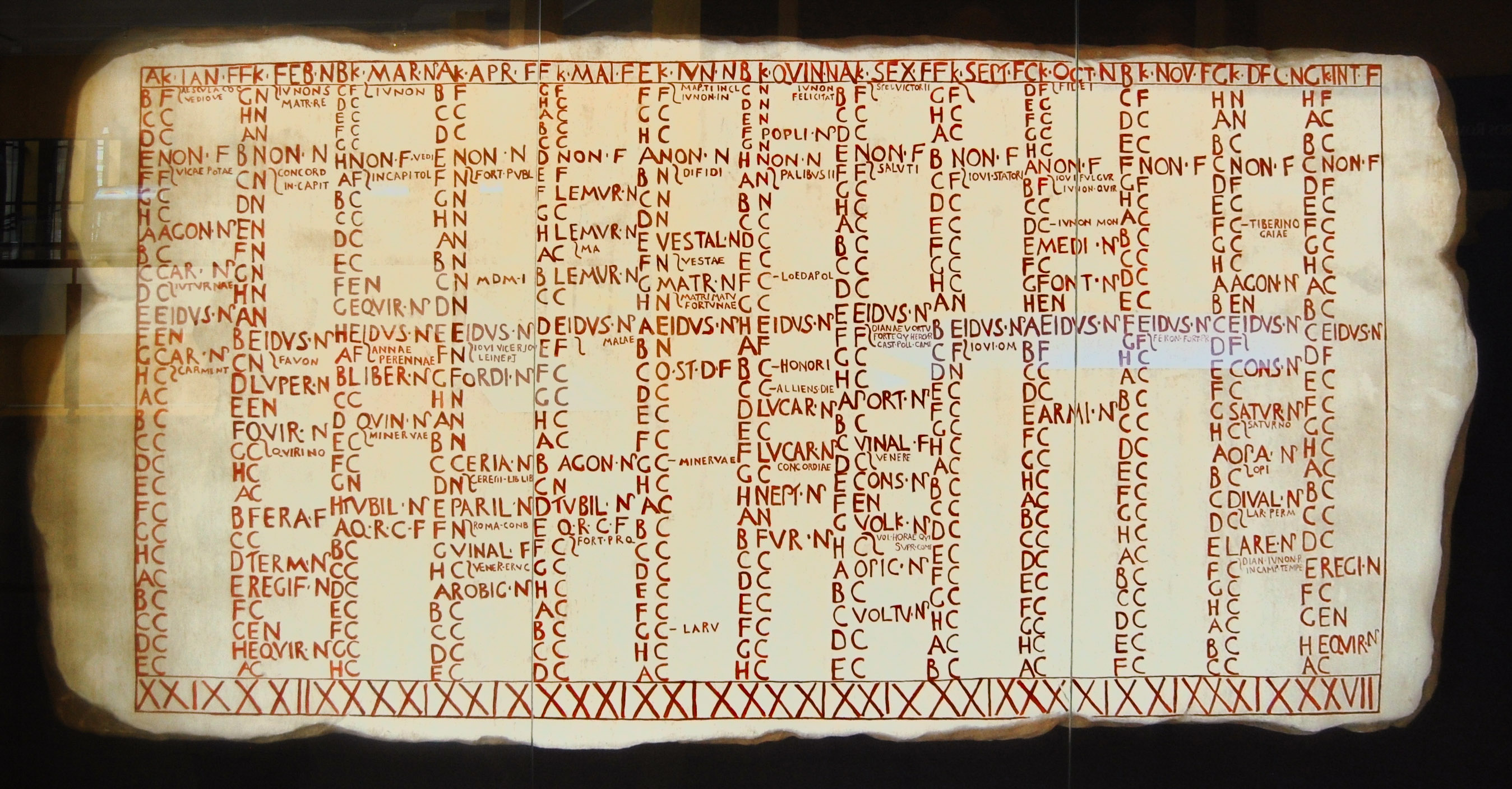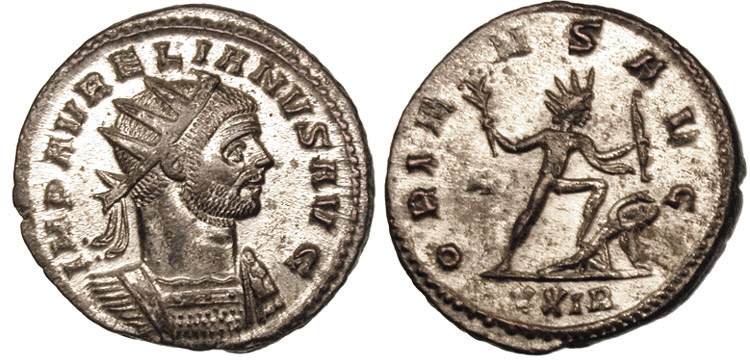|
December
December is the twelfth and final month of the year in the Julian and Gregorian calendars. Its length is 31 days. December's name derives from the Latin word ''decem'' (meaning ten) because it was originally the tenth month of the year in the calendar of Romulus , which began in March. The winter days following December were not included as part of any month. Later, the months of January and February were created out of the monthless period and added to the beginning of the calendar, but December retained its name. Macrobius, '' Saturnalia'', tr. Percival Vaughan Davies (New York: Columbia University Press, 1969), book I, chapters 12–13, pp. 89–95. In Ancient Rome, as one of the four Agonalia, this day in honour of Sol Indiges was held on December 11, as was Septimontium. Dies natalis (birthday) was held at the temple of Tellus on December 13, Consualia was held on December 15, Saturnalia was held December 17–23, Opiconsivia was held on December 19, Divalia was ... [...More Info...] [...Related Items...] OR: [Wikipedia] [Google] [Baidu] |
Saturnalia
Saturnalia is an Roman festivals, ancient Roman festival and holiday in honour of the List of Roman deities, god Saturn (mythology), Saturn, held on 17 December in the Julian calendar and later expanded with festivities until 19 December. By the 1st century BC, the celebration had been extended until 23 December, for a total of seven days of festivities. The holiday was celebrated with a sacrifice at the Temple of Saturn, in the Roman Forum, and a public banquet, followed by private gift-giving, continual partying, and a carnival atmosphere that overturned Ancient Roman culture, Roman social norms: Dice#History, gambling was permitted, and masters provided table service for their Slavery in ancient Rome, slaves as it was seen as a time of liberty for both slaves and freedmen alike. A common custom was the election of a "King of the Saturnalia", who gave orders to people, which were followed and presided over the merrymaking. The gifts exchanged were usually practical joke device ... [...More Info...] [...Related Items...] OR: [Wikipedia] [Google] [Baidu] |
Sol Invictus
Sol Invictus (, "Invincible Sun" or "Unconquered Sun") was the official Solar deity, sun god of the late Roman Empire and a later version of the god Sol (Roman mythology), Sol. The emperor Aurelian revived his cult in 274 AD and promoted Sol Invictus as the chief god of the empire. From Aurelian onward, Sol Invictus often appeared on imperial coinage, usually shown wearing a sun crown and driving a horse-drawn chariot through the sky. His prominence lasted until the emperor Constantine the Great, Constantine I legalized Christianity and restricted paganism. The last known inscription referring to Sol Invictus dates to AD 387, although there were enough devotees in the fifth century that the Christian theologian Augustine of Hippo, Augustine found it necessary to preach against them. In recent years, the scholarly community has become divided on Sol between traditionalists and a growing group of revisionists. In the traditional view, ''Sol Invictus'' was the second of two dif ... [...More Info...] [...Related Items...] OR: [Wikipedia] [Google] [Baidu] |
Winter Solstice
The winter solstice, or hibernal solstice, occurs when either of Earth's geographical pole, poles reaches its maximum axial tilt, tilt away from the Sun. This happens twice yearly, once in each hemisphere (Northern Hemisphere, Northern and Southern Hemisphere, Southern). For that hemisphere, the winter solstice is the day with the shortest daytime, period of daylight and longest night of the year, and when the Sun is at its lowest culmination, daily maximum elevation in the sky. Each Polar Circle, polar region experiences polar night, continuous darkness or twilight around its winter solstice. The opposite event is the summer solstice. The winter solstice occurs during the hemisphere's winter. In the Northern Hemisphere, this is the December solstice (December 21 or 22) and in the Southern Hemisphere, this is the June solstice (June 20 or 21). Although the winter solstice itself lasts only a moment, the term also refers to the day on which it occurs. Traditionally, in many Tem ... [...More Info...] [...Related Items...] OR: [Wikipedia] [Google] [Baidu] |
Julian Calendar
The Julian calendar is a solar calendar of 365 days in every year with an additional leap day every fourth year (without exception). The Julian calendar is still used as a religious calendar in parts of the Eastern Orthodox Church and in parts of Oriental Orthodox Churches, Oriental Orthodoxy as well as by the Amazigh, Amazigh people (also known as the Berbers). The Julian calendar was proposed in 46 BC by (and takes its name from) Julius Caesar, as a reform of the earlier Roman calendar, which was largely a lunisolar calendar, lunisolar one. It took effect on , by his edict. Caesar's calendar became the predominant calendar in the Roman Empire and subsequently most of the Western world for more than 1,600 years, until 1582 when Pope Gregory XIII promulgated a revised calendar. Ancient Romans typically designated years by the names of ruling consuls; the ''Anno Domini'' system of numbering years was not devised until 525, and became widespread in Europe in the eighth cent ... [...More Info...] [...Related Items...] OR: [Wikipedia] [Google] [Baidu] |
Gregorian Calendar
The Gregorian calendar is the calendar used in most parts of the world. It went into effect in October 1582 following the papal bull issued by Pope Gregory XIII, which introduced it as a modification of, and replacement for, the Julian calendar. The principal change was to space leap years slightly differently to make the average calendar year 365.2425 days long rather than the Julian calendar's 365.25 days, thus more closely approximating the 365.2422-day tropical year, "tropical" or "solar" year that is determined by the Earth's revolution around the Sun. The rule for leap years is that every year divisible by four is a leap year, except for years that are divisible by 100, except in turn for years also divisible by 400. For example 1800 and 1900 were not leap years, but 2000 was. There were two reasons to establish the Gregorian calendar. First, the Julian calendar was based on the estimate that the average solar year is exactly 365.25 days long, an overestimate of a li ... [...More Info...] [...Related Items...] OR: [Wikipedia] [Google] [Baidu] |
Yule
Yule is a winter festival historically observed by the Germanic peoples that was incorporated into Christmas during the Christianisation of the Germanic peoples. In present times adherents of some new religious movements (such as Modern Germanic paganism) celebrate Yule independently of the Christian festival. Scholars have connected the original celebrations of Yule to the Wild Hunt, the god Odin, and the heathen Anglo-Saxon ("Mothers' Night"). The term ''Yule'' and cognates are still used in English and the Scandinavian languages as well as in Finnish and Estonian to describe Christmas and other festivals occurring during the winter holiday season. Furthermore, some present-day Christmas customs and traditions such as the Yule log, Yule goat, Yule boar, Yule singing, and others may have connections to older pagan Yule traditions. Etymology The modern English noun ''Yule'' descends from Old English , earlier ''geoh(h)ol'', ''geh(h)ol'', and ''geóla'', sometime ... [...More Info...] [...Related Items...] OR: [Wikipedia] [Google] [Baidu] |
Roman Calendar
The Roman calendar was the calendar used by the Roman Kingdom and Roman Republic. Although the term is primarily used for Rome's pre-Julian calendars, it is often used inclusively of the Julian calendar established by Julius Caesar in 46 BC. According to most Roman accounts, #Romulus, their original calendar was established by their Roman legend, legendary list of kings of Rome, first king Romulus. It consisted of ten months, beginning in spring with March and leaving winter as an unassigned span of days before the next year. These months each had 30 or 31 days and ran for 38 nundinal cycles, each forming a kind of eight-day weeknine days inclusive counting, counted inclusively in the Roman mannerand ending with religious rituals and a Roman commerce, public market. This fixed calendar bore traces of its origin as an observational calendar, observational lunar calendar, lunar one. In particular, the most important days of each monthits kalends, nones (calendar), nones, a ... [...More Info...] [...Related Items...] OR: [Wikipedia] [Google] [Baidu] |
Sol Indiges
Sol is the personification of the Sun and a god in ancient Roman religion. It was long thought that Rome actually had two different, consecutive sun gods: The first, Sol Indiges (), was thought to have been unimportant, disappearing altogether at an early period. Only in the late Roman Empire, scholars argued, did the solar cult re-appear with the arrival in Rome of the Syrian Sol Invictus (), perhaps under the influence of the Mithraic mysteries. Publications from the mid-1990s have challenged the notion of two different sun gods in Rome, pointing to the abundant evidence for the continuity of the cult of Sol, and the lack of any clear differentiation – either in name or depiction – between the "early" and "late" Roman sun god. Etymology The Latin ''sol'' for "Sun" is believed to originate in the Proto-Indo-European language, as a continuation of the heteroclitic ''* Seh2ul- / *Sh2-en-'', and thus cognate to other solar deities in other Indo-European languages: Germanic ' ... [...More Info...] [...Related Items...] OR: [Wikipedia] [Google] [Baidu] |
Polar Night
Polar night is a phenomenon that occurs in the polar regions of Earth, northernmost and southernmost regions of Earth when the Sun remains below the horizon for more than 24 hours. This only occurs inside the polar circles. The opposite phenomenon, polar day or midnight sun, occurs when the Sun remains above the horizon for more than 24 hours. There are multiple ways to define twilight, the gradual transition to and from darkness when the Sun is below the horizon. "Civil" twilight occurs when the Sun is between 0 and 6 degrees below the horizon. Nearby planets like Venus and bright stars like Sirius are visible during this period. "Nautical" twilight continues until the Sun is 12 degrees below the horizon. During nautical twilight, the horizon is visible enough for navigation. "Astronomical" twilight continues until the Sun has sunk 18 degrees below the horizon. Beyond 18 degrees, refracted sunlight is no longer visible. True night is defined as the period when the sun ... [...More Info...] [...Related Items...] OR: [Wikipedia] [Google] [Baidu] |
Ancient Rome
In modern historiography, ancient Rome is the Roman people, Roman civilisation from the founding of Rome, founding of the Italian city of Rome in the 8th century BC to the Fall of the Western Roman Empire, collapse of the Western Roman Empire in the 5th century AD. It encompasses the Roman Kingdom (753–509 BC), the Roman Republic (50927 BC), and the Roman Empire (27 BC476 AD) until the fall of the western empire. Ancient Rome began as an Italic peoples, Italic settlement, traditionally dated to 753 BC, beside the River Tiber in the Italian peninsula. The settlement grew into the city and polity of Rome, and came to control its neighbours through a combination of treaties and military strength. It eventually controlled the Italian Peninsula, assimilating the Greece, Greek culture of southern Italy (Magna Graecia) and the Etruscans, Etruscan culture, and then became the dominant power in the Mediterranean region and parts of Europe. At its hei ... [...More Info...] [...Related Items...] OR: [Wikipedia] [Google] [Baidu] |
Summer Solstice
The summer solstice or estival solstice occurs when one of Earth's poles has its maximum tilt toward the Sun. It happens twice yearly, once in each hemisphere ( Northern and Southern). The summer solstice is the day with the longest period of daylight and shortest night of the year in that hemisphere, when the sun is at its highest position in the sky. At either pole there is continuous daylight at the time of its summer solstice. The opposite event is the winter solstice. The summer solstice occurs during the hemisphere's summer. In the Northern Hemisphere, this is the June solstice (20, 21 or 22 June) and in the Southern Hemisphere, this is the December solstice (20, 21, 22 or 23 of December). Since prehistory, the summer solstice has been a significant time of year in many cultures, and has been marked by festivals and rituals. Traditionally, in temperate regions (especially Europe), the summer solstice is seen as the middle of summer and referred to as midsum ... [...More Info...] [...Related Items...] OR: [Wikipedia] [Google] [Baidu] |
Frimaire
Frimaire () was the third month in the French Republican calendar. The month was named after the French word ''frimas'' 'frost'. Frimaire was the third month of the autumn quarter (''mois d'automne''). It started between 21 November and 23 November, ending between 20 December and 22 December. It follows Brumaire and precedes Nivôse Nivôse (; also ''Nivose'') was the fourth month in the French Republican Calendar. The month was named after the Latin word ''nivosus'' 'snowy'. Nivôse was the first month of the winter quarter (''mois d'hiver''). It started between 21 and 23 .... Day name table Like all FRC months, Frimaire lasted 30 days and was divided into three 10-day weeks called ''décades'' (decades). Every day had the name of an agricultural plant, except the 5th (Quintidi) and 10th day (Decadi) of every decade, which had the name of a domestic animal (Quintidi) or an agricultural tool (Decadi). Other exceptions are the 8th day (Honey) and the 11th day (Wax). T ... [...More Info...] [...Related Items...] OR: [Wikipedia] [Google] [Baidu] |








